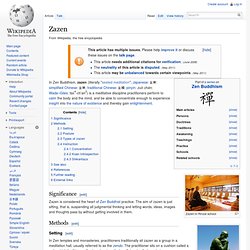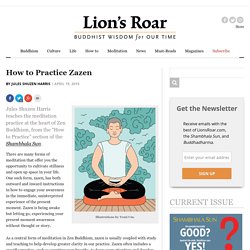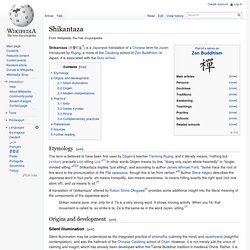Zoom
Trash

Zazen. In Zen Buddhism, zazen (literally "seated meditation"; Japanese: 坐禅; simplified Chinese: 坐禅; traditional Chinese: 坐禪; pinyin: zuò chán; Wade–Giles: tso4-ch'an2) is a meditative discipline practitioners perform to calm the body and the mind, and be able to concentrate enough to experience insight into the nature of existence and thereby gain enlightenment.

Zazen in Rinzai school Kosho Uchiyama writes that Auguste Rodin's The Thinker, in which the "back, waist, legs, arms, and even fingers" are curled up, is the opposite of zazen posture.[1] Significance[edit] Zazen is considered the heart of Zen Buddhist practice. The aim of zazen is just sitting, that is, suspending all judgmental thinking and letting words, ideas, images and thoughts pass by without getting involved in them. Methods[edit] Setting[edit] In Zen temples and monasteries, practitioners traditionally sit zazen as a group in a meditation hall, usually referred to as the zendo. Posture[edit] How to Practice Zazen. Illustrations by Tomi Um.

Jules Shuzen Harris teaches the meditation practice at the heart of Zen Buddhism, from the “How to Practice” section of the Shambhala Sun. There are many forms of meditation that offer you the opportunity to cultivate stillness and open up space in your life. One such form, zazen, has both outward and inward instructions in how to engage your awareness in the immediate, uninterpreted experience of the present moment. Zazen is being awake but letting go, experiencing your present moment awareness without thought or story. As a central form of meditation in Zen Buddhism, zazen is usually coupled with study and teaching to help develop greater clarity in our practice. There has been a lot of attention recently on the many practical benefits of meditation.
To make real progress in zazen, we must make a genuine commitment to practice. You should preferably sit in the morning, starting with ten minutes a day for the first week. How to do Zazen - Seated Meditation Video. Hi, I am Patrick and today we are talking about Zazen and how to do it.

Meditation isn't just for buddhas or monks; it's for everybody that can be done at almost any time. So let's get started. When you sit, you are going to want to elevate your pelvis. The most useful thing for this is something like a Zafu, it's a round Japanese shape. But honestly anything will work, a pillow folded in half, a rolled up blanket is just as good. As you sit, you want to have a stable base as possible.
And finally, classic full-lotus posture. Most important physical component of meditation is the spine. Another thing to look out for is the shoulders. Zazen can be done from anywhere between 15 minutes to one hour. The idea of the zazen is to have a clear empty mind without chattering thought. Like a monkey you are constantly climbing from tree to tree, the mind meets some random thoughts or random thought. I am only half as serious with these actions and things. Shikantaza. Shikantaza (只管打坐?)

Is a Japanese translation of a Chinese term for zazen introduced by Rujing, a monk of the Caodong school of Zen Buddhism. In Japan, it is associated with the Soto school. Etymology[edit] The term is believed to have been first used by Dōgen's teacher Tiantong Rujing, and it literally means, "nothing but (shikan) precisely (da) sitting (za). A translation of "shikantaza" offered by Kobun Chino Otogawa[6] provides some additional insight into the literal meaning of the components of the Japanese word: Shikan means pure, one, only for it. Origins and development[edit] Silent illumination[edit] Silent illumination may be understood as the integrated practice of shamatha (calming the mind) and vipashyana (insightful contemplation), and was the hallmark of the Chinese Caodong school of Chan.
Shikantaza's origins can also be traced back to silent illumination. Dogen[edit] Even still, Chan Master Shengyen states that shikantaza is similar to silent illumination.[8][12] Soto[edit] .. 10 Most Zen-Friendly Websites to Keep You Calm and Productive at Work. Do you feel like you can no longer cope with the stress of meeting your deadlines?

Does the lack of concentration stop you from focusing on your goals? Are you stuck or stressed out? Then put your headphones on. Try using some of the most Zen-friendly websites on offer that really work wonders for keeping your cool in the workplace. There are so many more sites like this out there, but — for the purposes of this article — I have included 10 of them that I use myself. 1. Yes, that’s exactly what you should do for the next two minutes. 2. Calm.com also challenges you to sit still and quiet your mind. You can choose from the many calming atmospheres that are available — gentle waves, fields, waterfalls. 3. SimplyNoise uses white, pink and brown noise. 4. SimplyRain belongs to the SimplyNoise website and it simply plays the rain sounds for you. 5.
This one’s my favorite and the one I use most often when I write.